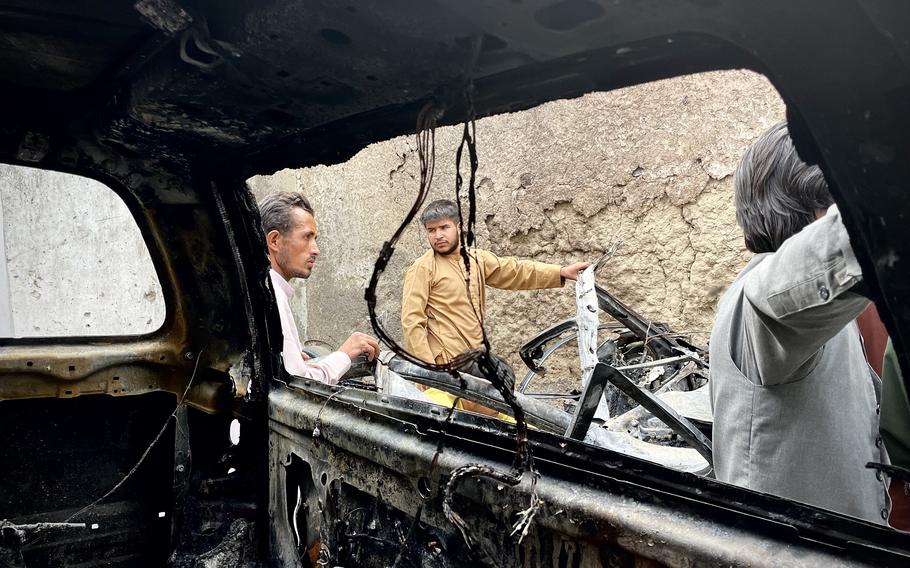U.S.
Trump moves to close Pentagon office focused on curbing civilian deaths
The Washington Post January 24, 2025

People in Kabul sift through twisted metal and rubble in the aftermath of a U.S. drone strike that killed 10 civilians in Aug. 2021. (Susannah George/The Washington Post)
The Trump administration is moving to abolish a Pentagon office responsible for promoting civilian safety in battlefield operations, suggesting that incoming Defense Department leaders may attempt to loosen restrictions on U.S. military operations worldwide.
In the days before Donald Trump’s inauguration, his transition team provided Pentagon officials with a set of orders outlining early priorities for his second term, including a desire to review and potentially abolish the Civilian Protection Center of Excellence, said a U.S. defense official. The office, housed within the Department of the Army, is tasked with helping the military to limit unintended civilian deaths.
As a result of that order, the Army has begun drafting a proposal to defund and potentially “disestablish” the office, according to five people familiar with the discussions and an internal document reviewed by The Washington Post. All spoke on the condition of anonymity to discuss the nascent plan.
Shuttering the office, which was established under a 2023 law, would require congressional approval. It was not immediately clear whether the Trump administration would seek to reallocate some of the center’s functions elsewhere.
“As is routine in a new administration, the [Defense Department] Agency Review Team tasked the Army to review its programs and responsibilities,” an Army spokeswoman, Cynthia O. Smith, said in a statement. “The Army continues to fund and support the Civilian Protection Center of Excellence” as the Pentagon department tasked with hosting it.
Spokespeople for Trump’s acting defense secretary, Robert G. Salesses, could not be reached immediately for comment.
The early moves suggest the Trump Pentagon may distance itself from a host of measures established under President Joe Biden to prioritize the safety of noncombatants in conflict zones. Trump’s nominee for defense secretary, Pete Hegseth, who has promised to make the U.S. military more lethal, has complained about overly restrictive rules of engagement and said that service members “fight lawyers as much as we fight bad guys.”
The center’s roots lie in the thousands of civilian deaths that occurred in decades of U.S. counterinsurgent operations following the 9/11 terrorist attacks on the United States. During Trump’s first presidency, as civilian deaths surged during the air war against the Islamic State, then-chairman of the Joint Chiefs Gen. Joseph F. Dunford Jr. oversaw a review of the military’s handling of civilian protection, setting in motion a process that led to the center’s establishment.
Under a follow-on plan established during the Biden administration, the Pentagon assigned specialists to military operations centers worldwide to advise commanders, incorporate civilian harm reduction into training exercises, refine data collection and improve the military’s response when deaths occur. The Center of Excellence, staffed by about 30 people with backgrounds in targeting, intelligence, civil affairs or humanitarian organizations, was established to share best practices across the military and assist commanders and battlefield personnel in integrating new information into their battle plans.
“If we want to protect our troops, we should continue to focus on these efforts rather than unwind them. Protecting civilians in conflict is both a moral and national security imperative,” Rep. Jason Crow (D-Colorado), an Army veteran who was involved in legislation that established the center, said in a statement. “I am ready to talk and work with anyone about why these efforts are important for national security and the safety of our troops.”
Officials who have worked in the Center of Excellence and on other aspects of the Pentagon’s system for improving its record on civilian harm have sought to counter the perception that it imposes constraints on military commanders as they target adversaries or establishes punitive measures for personnel carrying out such missions.
Rather, they described the system, which includes more than 150 people across Defense Department offices and combatant commands, as a tool that provides commanders more information as they conduct operations, informing targeters or military planners about patterns of life in a particular area, identifying cultural sites and averting unintended deaths before they occur.
“This certainly doesn’t prevent you from ‘taking the gloves off,’” a senior defense official said. “But what it means is, when you ‘put the gloves on’ … you’ll hit what you want to hit, and not what you don’t.”
Officials who work on civilian harm issues said in the lead-up to Trump’s inauguration that they were hopeful the system would find support under the new administration.
“This is an additional capability that we give to the force,” the senior defense official said. “This is all about avoiding unintended effects, and winning wars.”